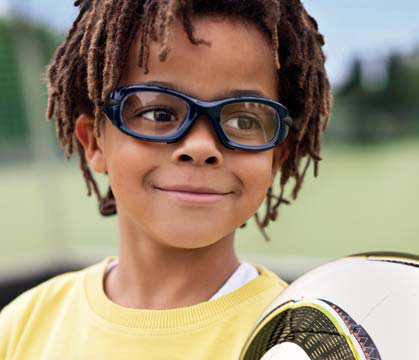
Choosing Protective Eyewear for Children Playing Football or Rugby
Best Eyewear for Children Playing Football or Rugby
Children can be resistant to the idea of wearing sports goggles for fear of "looking funny" when they play football or rugby, but they are quickly becoming an accepted part of the sport, much as bike helmets have become the norm for cycling and knee pads and elbow protection when skate-boarding.
Sport is now the biggest cause of hospital admission for serious eye injury in the UK and according to the National Society to Prevent Blindness, of the 120,000 eye injuries sustained each year, over 50% are attributable to those under 25.
Types of Eye Injuries
The types of eye injuries caused playing football or rugby can be divided into four categories:
- Corneal Abrasions, which is damage to the front surface of the eye. This is most commonly caused by scratches from fingernails and can be very painful.
- Blunt Trauma, which is caused when the eye is compressed through sudden impact. This can be from elbows, fists, or the ball etc. A mild injury may cause a black eye (swelling of the eyelids), or sub-conjuctival haemorrhage (bleeding behind the conjunctiva), though a black eye can mask a more severe injury.
- Penetrating Injuries, which can cause the eye to rupture. This is due to foreign objects such as a broken spectacle or contact lens being forced back into the eye. This is likely to cause severe damage to the eye, and result in swelling, bleeding and long term damage to vision and health.
- Ultra Violet (UV) radiation can damage the cornea and retina causing future problems such as cataracts, macular degeneration, photo keratitis (sunburn of the retina) or cancer of the eye. Children's eyes are much more sensitive to light than those of adults. Their pupils are wider and their ocular tissues contain less pigment. As UV absorption to the eyes is cumulative, they only have a certain amount of natural UV protection. It is when this threshold is exceeded that they will suffer problems with their eyes and eyesight.
It is much better to prevent an injury than cure one and is why football and rugby clubs are increasingly insistent on young children wear protective eyewear.
What type of eyewear is required?

When playing contact sports such as football or rugby, children need to wear adequate protection that has been designed to do that job. Ordinary spectacles and contact lenses do not protect the eye adequately from impact or projectiles, and on occasions, can be more dangerous if the glass or contact lens shatters.
Fortunately there has been a great deal of research and technology gone into making sports eyewear that is safe, durable and lightweight. Key features to look out for are as follows:
Frame considerations:
- Frame Design: Most sports frames are constructed of highly impact-resistant plastic or polycarbonate. Choose a wraparound design (For examples see the Leader Jam'n and Rec Specs ranges) that will provide good peripheral vision or ensure that the squarer goggles have good side protection (For examples see the Progear Eyeguard or Bolle Sports Protective ranges). This will ensure that the frame covers the entire eye socket protecting the eye from impact and UV radiation as well as providing protection against the wind and flying debris. Also look out for lightweight frame. They offer more comfort and are longer wearing.
- Padding: The frame should have padding at the temple points and bridge points to cushion any impact. Padding will absorb some of the shock and ensure the frame itself does not cause damage to the facial structures.
- Retaining Band: The frame should be secured by an elasticized band, not temple arms alone. The frame must be secured tight to the head so that it won't fall off. A frame with temple arms without an additional retaining band can easily fall off if nocked.
- None Slip Temples and Nose Grip: Non- slip rubber temples and nose grips are an additional feature that will help to hold the eyewear firmly on the face.
- Frame Venting System: Any feature that directs air through the frame will help to prevent fogging or condensation of the lens during intense activity.
Lenses considerations:
- Polycarbonate Lenses: They are very strong, lightweight and thin. They will not shatter on impact unlike the lenses in most glasses and non-sports sunglasses.
- UV Protection: Ensure that the lenses offer 100% UV protection.
- Lens Colour: If you are playing during the day, it is worth considering tinted frames. A brown colour can help distinguish the ball better against the blue of the sky or the green of the grass. If playing at night, you want the lens to be clear to give the best visual acuity. A yellow lens can also be used to cut the glare of overhead lighting. However, beware that the lens colour can reduce visual acuity at night slowing down reaction times.
Below are answers to a number of questions that we are frequently asked:-
Prescription Lenses: Direct fitting or clip-in behind the frame?
Where protective eyewear have been designed to take clip-in prescriptions, the clip-in prescriptions can be cheaper. This is because you do not need to purchase polycarbonate prescription lenses as the outer lens of the sports eyewear will be polycarbonate and provide the necessary impact protection. However, the down side is that a clip-in insert will limit periphery vision a little and as it is closer to the face, will be more prone to fogging. Overall, for football or rugby, we would recommend that you select frames that have been designed to take prescription lenses that fit directly into the frame.
What type of frames should I buy: Goggles or frames with temple arms?

It is a personal choice and both styles will perform well on the football pitch. Goggles have been designed with a retaining band attached to it and will generally fit firmer to the face than protective eyewear that have temple sides and a retaining band attachment. They are a better option for Rugby. Progear have recently launched a goggle specifically targeted at Rugby and other contact sports such a Ice Hockey, football, martial arts such as judo, karate and wrestling called Tackle. For those who have had eye problems or refractive surgery that have weakened the eye we would also recommend goggles. For those that can't decide or would like both options, VerSport and Wiley X Young Force offer interchangeable temple arms and goggle straps included in the price. Also Progear Eyeguard and the Leader C2 ranges offer goggle straps that can be bought separately for conversion.
What size of protective eyewear should I buy for my child?
It is important that goggles or protective glasses be fitted correctly for each wearer. There is a temptation to purchase goggles that are much too large in order to give the child "room to grow." A small amount of growing room is acceptable, and sports goggles are made to be a little flexible in terms of width adjustment. However, if the frame is much too large, the sides of the goggle will end up pressing against the soft flesh of the temples posing a danger to the child under impact. Allowing children to continue wearing goggles that are too small likewise poses problems. First, it's uncomfortable, and second, it will obstruct peripheral vision.
To select the correct size for buying on the web, either measure the width of an existing pair of glasses or sunglasses that fit them or measure the width of their face from temple to temple adding an additional 5mm to take account of temple padding – and room for growth! Proper fitting means that the padding inside the goggle's sides rests flush with the face and that the eyes are centred vertically in the lens area. Then select a pair based on width measurements. If you buy from Eyekit and they do not fit properly, just send them back and order a different size. There is no charge for returning an item and if there isn't anything else suitable, we will send you a full refund.
What are the RFU rules for wearing sports protective eyewear when playing Rugby?
The RFU stated in correspondence with Eyekit during September 2017:
"We do not specify which goggles players have to wear, EU compliant would of course be a minimum standard however it is important that they are appropriate for use in contact rugby (i.e. no sharp/hard edges etc.). World Rugby are also running a (global) trial in which they have specified which goggles should be worn, whilst this is not necessary in the RFU trial it may provide you with more information on the type of materials/design."
For our full range of sports protective eyewear, click here for protective Goggles and Glasses
- Ordering Prescriptions
- Lens Options Explained
- About Glasses
- About Sunglasses
- About the Eyewear Brands
- Eyecare
- Eye Conditions
- Frequently Asked Questions
- Blog
- About Us
- Why Choose Eyekit for your Prescription?
- Varifocal Prescriptions
- Tint Colour Options for Prescription Lenses
- Special Offers
- Guide to Buying Eyewear Online at Eyekit
- Choosing Eyewear for Sport
Latest From Eyekit
Rain Rain Go Away- Why you need a Crystal Vision Coating on your Prescription Glasses and Sunglasses
The snow was short lived but us Brits know that the Winter/ Spring showers have just begun. You know how it starts, you get out your bike or you figure out your hike for the day on the map and
Eyekit’s Top 10 Tips to Help You Keep Your New Year’s Resolution
Every year we make them and every year we try and try but eventually break them. So its time to stop the cycle and (maybe take up...
Our top 5 Eyewear items to Help Your Eyes this Lock Down
We have looked at our top 5 most popular Eyewear items that people needed during the last lockdown that could help you with this...
Veganuary - Can Excluding Animal Products Have an Impact on Your Eyesight?
We often make connections between diet and cardiovascular disease or obesity but we often forget that eye sight and vision loss is also linked to...
Winter Is Here
Here's how you can help out your eyes this winter. THE SUN HAS GOT HIS HAT ON- even in winter You might only think you need your sunnies...








